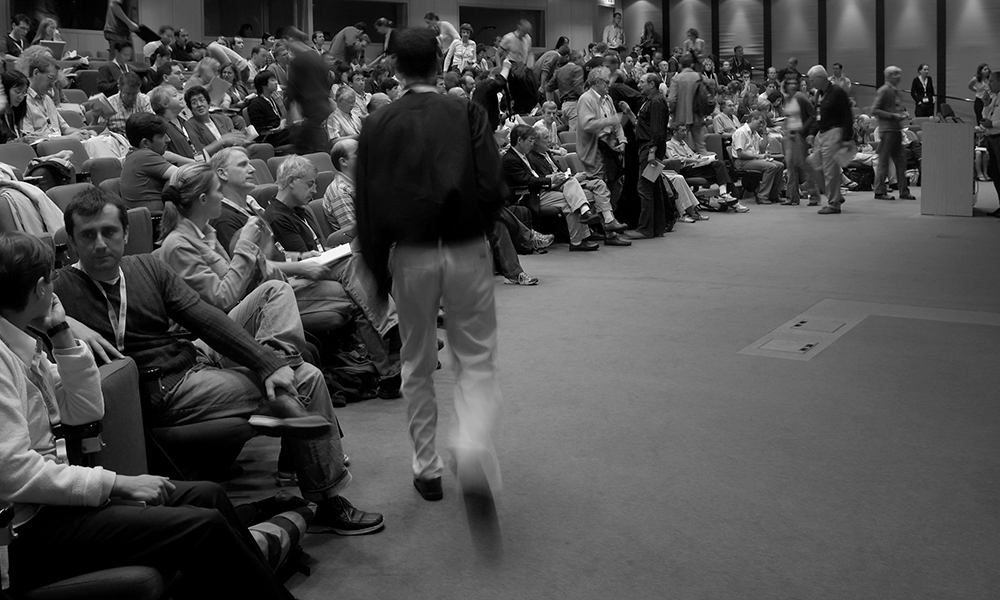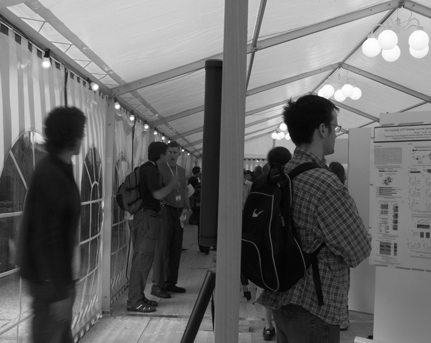Flashback Friday: Proteins translate into EMBL-Heidelberg’s biggest-ever conference

EMBL celebrates its 50th anniversary in 2024, and in so doing, we’re digging through the archives for some fascinating stories from EMBL’s past publications to republish in this blog.
EMBL is well known for hosting big, topical, and impactful conferences – very often with partners like EMBO, such as a recent AI and Biology conference. The following is an EMBLetc. article from issue 29 in October 2005 about what was the biggest-ever conference at that point in EMBL’s history.
By the registration deadline, over 320 scientists had signed up for the EMBO Conference on “Protein Synthesis and Translational Control”, held in mid-September at EMBL’s main laboratory. That made it the largest conference ever held on the Heidelberg campus. “The high interest in the programme wasn’t unexpected,” says Matthias Hentze, co-organiser alongside Anne Ephrussi (EMBL), Venki Ramakrishnan (LMB) and Alan Hinnebusch (NIH). “Scientifically, this is one of the traditional topics in biology, and recently it has moved to centre stage as we’ve discovered the crucial role it plays in processes such as development, the central nervous system, memory and disease.”
More than 70 talks showcased how far molecular biologists have come in understanding nuances of the synthesis of proteins. An enormous amount has been learned about the structures and functions of translation initiation factors, the complexes they form and how their regulation influences events in development and the function of neurons. Sessions focused on the ribosome, nonsense-mediated decay and how viral RNAs deal with the cellular translation machinery.
 “There is a high interest in coming to Europe and coming to EMBL. That leads to new contacts and collaborations.”
“There is a high interest in coming to Europe and coming to EMBL. That leads to new contacts and collaborations.”
A conference on this theme is held every two years at the Cold Spring Harbor Laboratory in the US, and it always draws a big crowd. Matthias says that the point behind organising another meeting in the alternate year, in Europe, wasn’t to compete. Instead, it would permit many more Europeans to attend who might not be able to spare the time or airfare to travel to the US.
It also brought the key players in the field to Heidelberg. Anne says: “Even though speakers and everyone else had to pay their own expenses and registration fees, they came. It showed that there is a high interest in coming to Europe and coming to EMBL. That leads to new contacts and collaborations. We get to see what scientists from the US and other countries are doing, and they are exposed to European science – as well as EMBL – which can’t be done very easily in another way.”
The more attendees, the merrier?

Opening the doors to a record number of participants required some fancy footwork on the part of the organisers and EMBL’s conference team. The Operon, where talks would take place, only holds 300 people. And the 320 registrations didn’t include staff from EMBL and EMBO, who could be counted to drop in on the talks. Doros Panayi and his team from the Photolab and Courses and Conferences office quickly arranged for the talks to be broadcast live to an overflow crowd in room 202. Additionally, nearly 200 participants brought along posters – in some cases more than one. There was no way they could be squeezed into the Operon Foyer, the usual poster display area, so Mustafa Uyguner and his crew from the Housekeeping Service quickly set up tents outside the main entrance. It made for five hectic days behind the scenes during the conference itself, on top of weeks of preparation, but in the end everything ran smoothly.
High numbers of young group leaders, postdoctoral and predoctoral fellows attended the event. “Conferences have always been an important part of EMBL’s mission to provide advanced training,” Anne says. “Having them in Europe promotes the participation of young European scientists, bringing them into contact with important people in the field. Cold Spring Harbor’s activities have been a huge advantage for young American researchers, and Europe has lacked a training centre of comparable breadth and quality. We’ve been doing these kinds of activities at EMBL, but we can do much more, and every bit of it will stimulate European science.”
“If we could establish such a centre at EMBL, it could be virtually self-financing,” Matthias says. “That’s the model at the Cold Spring Harbor Laboratory, and if there were any doubts that the model would work in Europe, this event has laid them to rest.”
This article was originally published in EMBLetc., issue 25 in October 2005. Later on, EMBL would go on to build its Advanced Training Centre (ATC), to hold far bigger conferences and other training events. Find more stories related to EMBL events here.